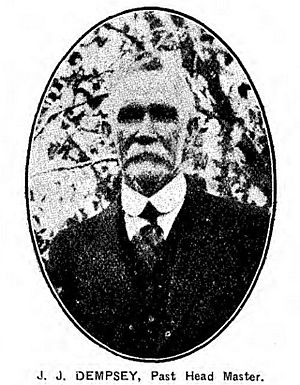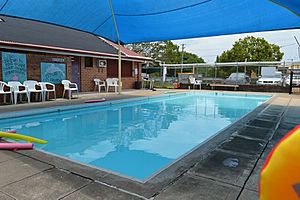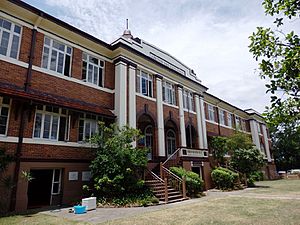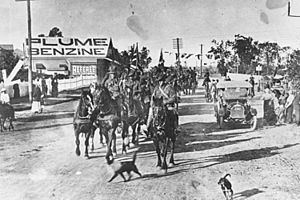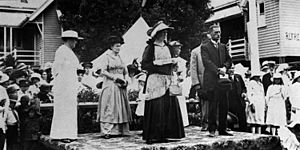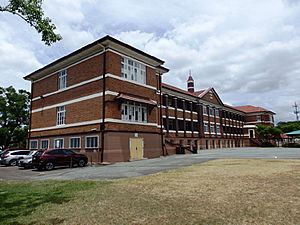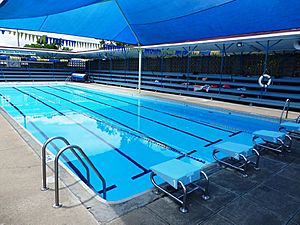Junction Park State School facts for kids
Quick facts for kids Junction Park State School |
|
|---|---|
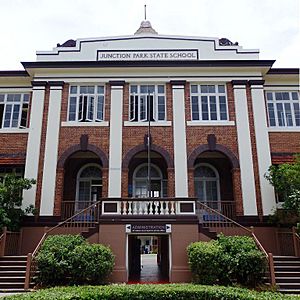
The front entrance of the brick school building, seen from Waldheim Street in 2015.
|
|
| Location | 50 Waldheim Street, Annerley, City of Brisbane, Queensland, Australia |
| Design period | 1919–1930s (Interwar period) |
| Built | 1909–1910, 1928–1929, 1934, 1935–1936, 1935 |
| Architectural style(s) | Classicism |
| Official name: Junction Park State School; Thompson Estate State School (former) | |
| Type | state heritage |
| Designated | 6 May 2016 |
| Reference no. | 650023 |
| Type | Education, Research, Scientific Facility: School – state (primary) |
| Theme | Educating Queenslanders: Providing primary schooling |
| Builders | Queensland Department of Public Works, MR Hornibrook |
| Lua error in Module:Location_map at line 420: attempt to index field 'wikibase' (a nil value). | |
Junction Park State School is a historic school in the Brisbane suburb of Annerley. It first opened in 1891 and is known for its beautiful old buildings and long history. The school is listed on the Queensland Heritage Register, which means it is a special place that is protected for its importance to Queensland's history.
Contents
The School's Long History
Junction Park State School started as the Thompson Estate State School in 1891. It was built for the families moving into the growing suburbs south of Brisbane. The area was once home to the Turrbal and Jagera people.
The school has been a center of the community for over 130 years. It still has some of its oldest structures, including two swimming pools and a grand brick building from the 1930s.
Why Was a School Needed?
In the late 1800s, Brisbane was expanding. Farms in the Annerley area were being turned into suburbs. More families meant more children needed a place to learn. Before Junction Park, the closest schools were in Yeronga, Coorparoo, and Dutton Park.
The government believed education was very important. In 1875, it made primary school free and required all children to attend. This led to many new schools being built across Queensland. Communities often helped build their local school, which became a source of pride.
From a Cottage to a State School
The school's journey began in 1888 in a small rented cottage. It was a "provisional school," which was a temporary school for small communities. It started with 52 students but quickly grew.
By 1891, it had become a proper state school, renamed Thompson Estate State School. A new timber school building and a teacher's house were built on land donated by the local government. On the first day, 425 students showed up, far more than the 280 the school was built for! A year later, in 1892, it was given its current name: Junction Park State School.
Cool Features of the School
The First School Swimming Pool
Junction Park was the first state school in Queensland to have its own swimming pool. Before the pool, students swam in a local creek, but this was not always safe.
The first pool, built in 1909, was small and cost £175. The community raised most of the money. It was seen as a memorial for four young students who had drowned in a waterhole years earlier. It was also thought that learning to swim would help train boys for the Australian navy.
As the school grew, a bigger pool was needed. A second, larger pool was built in 1929. It was 75 feet long (about 23 meters) and is still used today. The smaller 1910 pool was kept for younger students to learn in.
The Grand Brick Building
The 1930s was a tough time in Australia because of the Great Depression. Many people lost their jobs. To help create jobs, the Queensland Government started a big building program. This included constructing large, beautiful brick schools.
Junction Park's impressive brick school building (Block A) was built between 1935 and 1936. It was designed to be a symbol of strength and hope during a difficult period. The building is two stories high with a large undercroft (a covered area underneath) for students to play in. It has a classic design with arches, columns, and a grand entrance.
The building had 21 classrooms, offices for teachers, and large assembly rooms. It was a modern and well-designed space for learning. At the same time, new brick toilet blocks and concrete retaining walls were built to level the school grounds.
The School During Wartime
The school and its community played a part in both World War I and World War II.
During World War I, students and their families raised money for the troops. An honour board from 1915 lists the names of 86 former students who served in the war. In 1915, the school even provided breakfast for soldiers on the March of the Dungarees, a famous recruitment march.
During World War II, there were fears of an invasion. The government closed coastal schools for a short time in 1942. At Junction Park, students and parents dug zig-zag trenches around the oval to use as protection during air raids.
The School Today
Junction Park State School is still a busy and important part of the Annerley community. While some new buildings have been added over the years, the historic heart of the school remains.
The 1936 brick building, the two swimming pools, and the old toilet blocks are still there. The school grounds also have beautiful mature trees and the retaining walls built during the Great Depression.
What Makes the School Special?
Junction Park State School is on the Queensland Heritage Register because it tells an important story about Queensland's history.
- A Story of Education: The school shows how education has changed over time. The grand brick building is a perfect example of the schools built during the Great Depression.
- Community Hub: For generations, the school has been a gathering place for the Annerley community.
- Beautiful Design: The main brick building is admired for its classic style and high-quality construction. It was designed to look permanent and impressive.
- Early Swimming Pools: The 1910 and 1929 pools are special because they show the early focus on teaching children to swim for safety.
Description of the Historic Buildings
The Brick School Building (Block A)
Block A is a large, symmetrical brick building. It has two stories plus an undercroft play area. The roof is tiled and has a small spire called a fleche. The main entrance on Waldheim Street has a grand staircase and arched windows.
Inside, many of the original classrooms, hallways, and staircases are still in place. There is even a timber honour board from 1915 in one of the rooms. The building's large windows and high ceilings were designed to make classrooms bright and airy.
Swimming Pools and Stands
The two concrete swimming pools are located next to each other. The larger 1929 pool has tiered wooden seating (stands) for spectators. These stands are sheltered by a modern roof.
Toilet Blocks
The three brick toilet blocks from 1934 match the style of the main building. They are single-story buildings with distinctive Dutch-gable roofs. While the inside has been updated, the outside looks much as it did in the 1930s.
Grounds and Trees
The school grounds include a large oval and several terraced areas created by concrete retaining walls. There are many mature trees, including large fig trees, that provide shade for students. Some of these trees are nearly as old as the school itself.
Notable People
- Romeo Lahey, a famous conservationist who helped protect Queensland's forests, attended the school.
- Doug Sherrington, who served as a Member of the Queensland Legislative Assembly, was also a student here.


